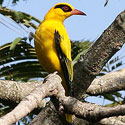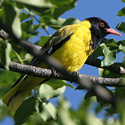|
Family: Oriolidae (orioles)
Life
> Eukaryotes >
Opisthokonta
> Metazoa (animals) >
Bilateria >
Deuterostomia > Chordata >
Craniata > Vertebrata (vertebrates) > Gnathostomata (jawed
vertebrates) > Teleostomi (teleost fish) > Osteichthyes (bony fish) > Class:
Sarcopterygii (lobe-finned
fish) > Stegocephalia (terrestrial
vertebrates) > Tetrapoda
(four-legged vertebrates) > Reptiliomorpha > Amniota >
Reptilia (reptiles) >
Romeriida > Diapsida > Archosauromorpha > Archosauria >
Dinosauria
(dinosaurs) > Saurischia > Theropoda (bipedal predatory dinosaurs) >
Coelurosauria > Maniraptora > Aves
(birds) >
Order: Passeriformes
Species indigenous to southern Africa
|
Oriolus
auratus (African golden oriole) The
African golden oriole occurs in large areas of sub-Saharan Africa, avoiding
lowland forest and arid areas. In southern Africa it is widespread in the
north, preferring miombo (Brachystegia) and broad-leaved Burkea
woodland. It feeds on insects and fruit, mainly foraging among the tree
canopy in mixed species flocks, occasionally coming down to ground level.
The nest is woven cup made of dry grass and plant detritus held together
with spider web, placed between the two branches of a fork, well away from
the tree trunk. |
 |
|
Oriolus
chlorocephalus (Green-headed oriole) |
 |
|
Oriolus
larvatus (Black-headed oriole) The Black-headed oriole is common and widespread, occuring
throughout sub-Saharan Africa, from East Africa to southern Africa. It is quite
adaptable, occupying a variety of habitats, including savanna woodland, parks,
farmland and gardens. It eats a variety of invertebrates, fruit and seeds, often
foraging in mixed species flocks in the tree canopy. The nest is deep cup of
woven old-man's beard strands, moss and grass, place between stems of a fork in
a slender tree branch. |
 |
|
Oriolus
oriolus (Eurasian golden oriole, European golden oriole) |
 |
|
